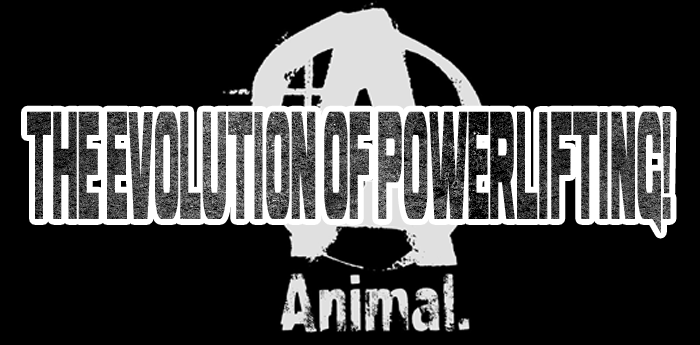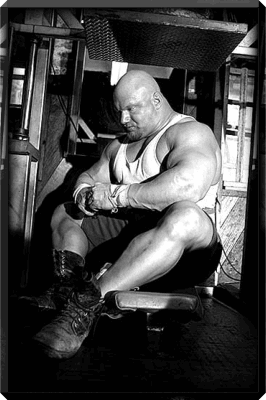
Top Sellers
50 Best Newest Protein Pre-Workout Post-Workout Fat Loss Intra-Workout Powerlifting Books
Training Accessories
Videos
Workout Music
Powerlifting Books
Training Accessories
Videos
Workout Music

A short and descriptive article on the history of powerlifting!
Last updated on October 08, 2019
 The pioneers of our sport began competing with the three lifts we know as the squat, bench press and the deadlift some 40+ years ago. There was no supportive gear to speak of during those early days, so there was not much to argue about in that area. The weight equipment was also very primitive, with small, narrow bars, small narrow benches and very small squat stands. The squat was always the lift that was most sought after for the highest support. It was during these early days that lifters began experimenting with different methods of support for the squat.
The pioneers of our sport began competing with the three lifts we know as the squat, bench press and the deadlift some 40+ years ago. There was no supportive gear to speak of during those early days, so there was not much to argue about in that area. The weight equipment was also very primitive, with small, narrow bars, small narrow benches and very small squat stands. The squat was always the lift that was most sought after for the highest support. It was during these early days that lifters began experimenting with different methods of support for the squat.
At first, powerlifters began wrapping themselves in sheets for support, noticing that the tighter they wrapped the sheet, the more weight they could lift. The next item used for support was “blue jeans”. Blue jean shorts began a trend that lasted for several years. If they blew out during a workout, they would patch them up and continue to use them. A belt was added for extra support and soon after, ace bandages were used for knee support. It was several years before the one piece lifting suit was incorporated into competition.
The “supersuit” was designed and made the biggest impact during this time, along with stronger knee wraps and wider belts. Lifters began adjusting their stance wider to get full benefit out of the new lifting gear. As time went on and different companies began developing tighter, stronger gear, the amount of weight lifted went up. Today's squat suits vary from single layer polyester to multiple layers of polyester, from single layer denim and canvas to multiple layers of each or both.
Some custom designs have velcro added on the shoulder straps to adjust the tightness and support of the suit. I was told recently by one designer that he's has a new one with drawstrings to help adjust the tightness in the sides of the suit. The wraps of today are also highly advanced with a stronger rubber-band material that is wider and longer. These are worn on the knees and wrists. Squat briefs or power-shorts are another added piece of gear under the squat suit, made out of the same materials and designs as the suits.
As the weights got heavier, the weight equipment became “heavy duty”. Squat stands went from wooden stands, to adjustable racks, to jack stands, to hydraulic squat racks and finally the mono-lift squat rack of today. In the early days, walking back with a heavy weight on your back was considered part of the squat. But in reality, the lift begins when the judge gives you the squat signal. What the mono-lift squat rack of today does is eliminate the dangers of walking back with that heavy weight on your shoulders, placing all that weight on one leg with each step you take.
With this squat rack, you get in your squat stance under the bar and just stand up. The racks or hooks come out from under you. Once you complete the squat, the hooks are brought back and you set the weight down. Each advancement in gear and equipment is designed with several elements in mind. The main concern is the lifter's safety. Next is the highest possible support it can give to aid the lifter in lifting the heaviest weight possible. The highest squat in competition is 1201lbs.
Now, the bench press is a totally different animal and of the three, the most popular lift. It began with only the lifter lying on a narrow bench with small steel weights. Different hand grips and bar placement were the only tools back then. As time went on and the weights increased, elbow and wrist wraps were used along with a small belt. The bench became more sturdy-heavier and a wider rack was installed. From that point on, the only changes were adjustable racks, a thicker padding with a non-slip surface and a step for the lift-off person. The gear worn has increased as well. Bench shirts are worn for extra support and safety. The transition of it is the same as the squat suit-utilizing an open back and closed back shirt made with the various layers and materials.
The form and technique used in the bench press has probably changed the most of the three lifts. Because an arch in your back is allowed (by keeping your butt and shoulders on the bench), some lifters have begun placing their feet behind them and up on their toes to get the maximum arch. Squeezing your shoulder blades together, keeping your feet in place, pushing off of the bar downward can create an even higher arch. This technique enables a lifter to get the most advantage out of their entire body during the bench press. While lowering the bar, with the widest grip allowed, they can tuck their elbows and raise their head to allow the bar to touch their chest. Once the press signal is given, the lifter can reverse this process by using the support of the bench shirt to catapult the weight to lockout. The highest bench press in a contest today is 1,005lbs.
The deadlift has always been considered the real test of strength. This is mainly because it is truly brute strength and not much, if any gear, can add pounds to this lift. In the beginning, it was just the lifter and the weight from the ground to standing erect with the weight at arms length. As I said, not much has changed today-adding a thick supportive belt, a tight supportive suit, wrist wraps and maybe knee wraps if the lifters chooses.
There are a couple of different stances taken to pull a heavy deadlift. The close stance or conventional stance is the most common, with the lifter's feet just a few inches apart. The other is called the sumo stance, with the feet wide and arms inside the legs. Most lifters use what's called an uneven grip. By this, I mean one hand is turned opposite from the other for better grip. Some lifters of today are starting to utilize a double overhand grip, which is extremely difficult to learn. By using the overhand grip, the lifter can keep the bar in closer to their body without twisting, but enabling them to start in a higher position. The highest deadlift in a contest today is 932lbs.
Tags: Strength Life Strength Programs Bemch Press Deadlift Squats Conditioning Core

Thank You...

Send Us Your Comments:
ArticleTitle - Comments
Sponsored Products:
Comments: